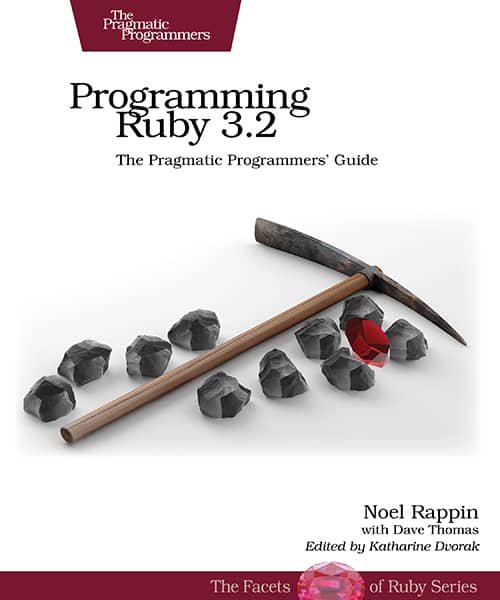Programming Ruby 3.2 (5th Edition) (Pragmatic Bookshelf)
PragmaticBookshelf
Noel Rappin @noelrappin, with Dave Thomas @pragdave
Ruby is one of the most important programming languages in use for web development. It powers the Rails framework, which is the backing of some of the most important sites on the web. The Pickaxe Book, named for the tool on the cover, is the definitive reference on Ruby, a highly-regarded, fully object-oriented programming language. This updated edition is a comprehensive reference on the language itself, with a tutorial on the most important features of Ruby—including pattern matching and Ractors—and describes the language through Ruby 3.2.
Would you like to go from first idea to working code much, much faster? Do you currently spend more time satisfying the compiler instead of your clients or end users? Are you frustrated with demanding languages that seem to get in your way instead of helping you get the work done? Are you using Rails and want to dig deeper into the underlying Ruby language? If so, then we’ve got a language and book for you!
Ruby is a fully object-oriented language. The combination of the power of a pure object-oriented language with the convenience of a scripting language makes Ruby a favorite tool of programmers that want to get things done quickly and cleanly.
This comprehensive reference manual for Ruby includes a description of the most important standard library modules, built-in classes, and modules. It also includes all the new and changed syntax and semantics introduced through Ruby 3.2, including pattern matching and Ractors, and describes the language through Ruby 3.2.
Noel Rappin is a Staff Software Engineer at Chime Financial. He is the author of multiple technical books including Rails 5 Test Prescriptions and Modern Front End Development With Rails, and was the host of the Tech Done Right Podcast. Follow Noel on Twitter @noelrap, and online at noelrappin.com.
Dave Thomas is a cornerstone of the Ruby community, and is personally responsible for many of its innovative directions and initiatives. He is one of the founders of the Pragmatic Programmers and the Pragmatic Bookshelf.
- Full details: https://pragprog.com/titles/ruby5/programming-ruby-3-2-5th-edition/
- View this book’s portal and details on how to post errata and suggestions here.
Don’t forget you can get 35% off with your Devtalk discount! Just use the coupon code “devtalk.com" at checkout ![]()
Latest Threads About This Book

Most Active This Week

Most Active This Month

Most Active This Year

Most Active Last Three Years

Most Active Over Three Years

Latest in Programming Ruby 3.2 (5th Edition)
Get money off!

The Pragmatic Bookshelf
35% off any eBook
Use the coupon code "devtalk.com" to get 35% off any eBook published by PragProg!









